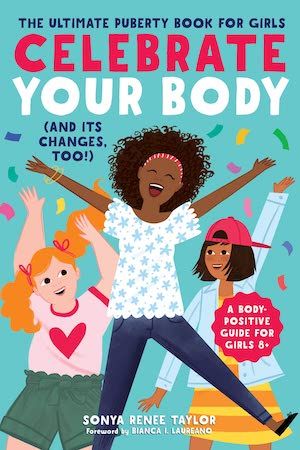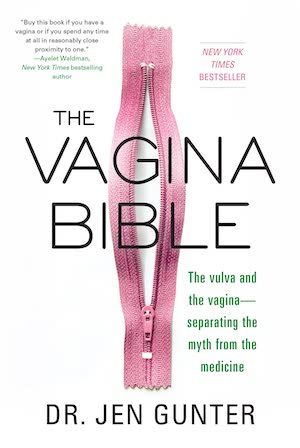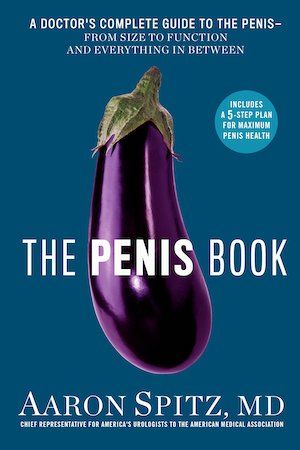
Helpful Books to Teach Sex and Anatomy to Kids of All Ages
The 1970s were a big decade for reproductive rights in the U.S., but it feels like right now we’re not too far from where we were half a century ago. In 1971, the book Our Bodies, Ourselves was published (technically, it was published a year earlier in pamphlet form). Two years later, Roe v. Wade was passed. Yet here we are in the year 2022 and book banning movements are pulling all manner of books from the shelves of public schools and libraries.
Aside from the obvious and myriad ways I find this form of censorship deeply disturbing (and infuriating), I also find myself concerned in my capacity as the parent of a young child.
As the American College on Obstetricians and Gynecologists has found, there are so many important gains accomplished through a comprehensive sexuality education. Yet with books about puberty, anatomy, sex, and sexuality being targeted in book banning campaigns, kids’ ability to access materials that will help them gain this education (especially when their parents or schools will not) is in serious peril.
The overturn of Roe v Wade only makes the importance of educating kids more important. After all, kids need to understand how the human body works (especially if access to abortions is limited). And when it comes to sex, knowledge is crucial for safety.
As authors and pediatricians Lisa Klein and Carrie Leff explain, “Some parents believe that telling children the truth about sex and our bodies will spoil their innocence. But innocence and ignorance are not the same.” (Ironically, this comes from an article Klein and Leff wrote about why their book on puberty was banned.)
As I put together this list, I noticed a dearth of available materials by authors of color. It’s widely acknowledged that there’s a “diversity gap” in the publishing industry, especially where children’s literature is concerned. In fact, even though portrayals about people of color have been on the rise in children’s lit in recent years, it turns out there has been little change in the number of books written by people of color.
While the diversity gap in children’s literature is not a new thing, it’s especially problematic where sex education is concerned. A recent study by Indiana University researchers Yael R. Rosenstock Gonzalez, Deana Williams, and Debby Herbenick found that there is very little representation of darker skin tones in sex ed textbooks. The study is difficult to access without access to a university library system, but a summary of it on Phys.org discusses how youth of color who don’t see themselves represented in educational materials “may avoid or delay sexuality education opportunities or clinical care if they do not see themselves represented in recommended resources.”
Add to this the issue that in the U.S., the vast majority of doctors are white — with a 2021 study finding that even though white men no longer statistically dominate the medical industry (broadly defined), there have only been small increases in Black and Hispanic doctors (male or female) in the past 20 years — and the larger picture becomes even more clear. Since a good proportion of sex ed books available for young readers (and adults, actually) are authored by physicians, the lack of racial diversity in the medical industry undoubtedly inflects authorship. And when you combine that with the issues in the publishing industry discussed above…well, the impact is clear.
Alongside the lack of materials penned by authors of color, there’s also a clear heteronormative bent to many of the books about bodies and sexuality out there right now. I guess this isn’t surprising. As Matthew Todd points out in the article “Rewriting History,” “for over the past 20 years the [publishing] industry has championed literary” LGBTQ+ stories — but not doing nearly as much work normalizing queer bodies, lives, or issues in nonfiction.
Point in case, in a 2018 report on LGBTQ+ literature for young readers, the Cooperative Children’s Book Center at the University of Wisconsin-Madison found that of 3700 books received in the year 2017, not even 4% had significant LGBTQ+ content; just over half of those were written by an author who identifies as LGBTQ+. Even more concerning, only 9 books — out of 3700! — were nonfiction. That’s less than 1/4 of a percent of children’s and teen literature, y’all.
And while these statistics are a few years old, the implications are clear: if less than a fraction of a percent of books for young readers contain significant LGBTQ+ content and are nonfiction, then where are all the educational books on bodies, puberty, and sex for kids (whether they identify as LGBTQ+ or not)?
With all this in mind, it’s good that diverse representations are increasing (however incrementally) in publications for kids and teens, but where sex ed is concerned it’s especially important to locate materials that speak to kids of all colors, orientations, genders, and abilities. I’ve curated a list of books that does as much of this work as possible, but the skewed demographics influenced by the publishing and medical industries are real and are reflected in my selections.
Even so, I hope this list of sex education books for kids can serve as a resource for anyone who wants kids — of all ages — to have access to materials that will help them learn about their own bodies. I’ve organized the list so that it begins with picture books for early readers and moves to more in-depth books for adolescents (or even adults), so as you progress through the list, the age of the expected reader advances.
Sex Education Books for Kids

What Makes a Baby by Cory Silverberg
This is one of my favorite books for wee ones. It talks about pregnancy and birth without buying into heteronormative parental structures. It’s colorful, depicting people with a variety of hair textures in colors like pink and green and purple, thereby sidestepping potential implicit messages about race. It talks about bodies that have sperm and those that have eggs without gendering those bodies, which is particularly clever. With What Makes a Baby, kids get the basics about how babies are made without any references to sex or sexuality. (As an added bonus, Silverberg has also written books on sex and puberty aimed at older kids, and also co-authored a book about sex and disability.)

The Gender Wheel: A Story About Bodies and Gender for Every Body by Maya Christina Gonzalez
The Gender Wheel takes a holistic approach to teaching young kids about both bodies and gender. I love that this book talks about the connection between our inner and outer bodies, delving into a historical perspective on why many people assume there are only two kinds of bodies (girl or boy). It’s also a beautiful book, both in terms of Gonzalez’s rich illustrations and beautiful prose. This profound line especially stood out to me: “We are not now nor have we ever been two kinds of bodies, two genders or two ways to behave in the world. We were never two. We have always been infinity.” For the teachers in the room, Gonzalez has created an entire curriculum available for free online to supplement this book (not to mention a “school edition” that “puts clothes on all the kids” in the illustrations).

Let’s Talk About Body Boundaries, Consent and Respect by Jayneen Sanders
This book, aimed at grade school children, teaches younger kids about (as per the subtitle) body ownership, respect, feelings, choices, and recognizing bullying behaviors. It uses colorful illustrations and questions in tandem to get readers thinking about boundaries of all kinds. One thing I especially appreciate about this book is that it invites conversation since it presents a series of scenarios for young readers to talk about with the adults in their lives. While it’s not directly about anatomy or sex, it lays important groundwork that can help young children keep their bodies safe by learning about consent and appropriate boundaries.

The Every Body Book : The LGBTQ+ Inclusive Guide for Kids About Sex, Gender, Bodies, and Families by Rachel E. Simon
This book for middle grade readers only came out in 2020, but it’s already a staple. Thoughtfully inclusive, it has chapters on sex, anatomy, emotions, reproduction, family, and consent. As if that range of topics wasn’t enough for you, it spends a little time dealing with sex in the media and includes resources for kids. The illustrations will help keep interest and also depict a diverse array of humans. If you like The Every Body Book, then you may also want to peruse You-ology: A Puberty Guide for EVERY Body (published by the American Academy of Pediatrics).

Puberty is Gross but Also Really Awesome by Gina Loveless
I wish I’d had this book when I was a preteen! It’s super informative, and it’s written in total kid speak. I mean, there are chapters called “Hair, Hair Everywhere!” and “Stinky and Wet (All About Sweat).” As an adult, I appreciate the way it’s organized into two parts — one on physical changes and another that’s holistic, looking at dynamics that move beyond body parts and physiology. For instance, there are chapters on gender, mental health, nutrition, technology, and more. With lively illustrations throughout and inclusive language (whether that’s references to foster parents or gender identity), this is a wonderful resource for any curious young person and the adults in their life.

Celebrate Your Body (and Its Changes, Too!): The Ultimate Puberty Book for Girls by Sonya Renee Taylor
Aimed primarily at cis girls, this book is a strong starting point for learning about puberty. (The cis boy counterpart to this book, which shares the same structure, is called Growing Up Great!: The Ultimate Puberty Book for Boys.) Designed for middle grade readers, it has the necessary chapters on anatomy and physiology, as well as chapters on emotions and safe spaces. I particularly appreciate that Taylor (celebrated author of the book for adults called The Body is Not an Apology: The Power of Radical Self-Love) opens with a discussion of what “puberty” is. I think this is a discussion that too often gets taken for granted. If you like this book, there are several other books in the series that are aimed at preteen and teen audiences, many of which delve more into topics like relationships, sex, and sexuality.

Everything You Always Wanted to Know About Puberty — and Shouldn’t Be Googling: For Curious Boys by Morris Katz
This book is fantastic — and if you like this one, they are slated to release a companion book called Everything You Always Wanted to Know About Puberty — and Shouldn’t Learn on TikTok: For Curious Girls this October. Regardless, Katz’s book is a comprehensive overview of puberty and its attendant social pressures and dynamics. Broken into three parts (one on physical changes, one on emotional changes, and another on social changes), it shares an appealing visual aesthetic with comic books. And the content is great, too — I love that it tackles physical, emotional, and social changes (there’s even a section on toxic masculinity!) through a combination of information, humor, and personal anecdote.

Queer: The Ultimate LGBTQ Guide for Teens, 2nd Edition by Kathy Belge and Marke Bierschke
One of the coolest things about this book is how relatable it is. Part of this comes from the writing style, which directly addresses the reader and elicits quite a few laughs along the way; part of it also comes from the inclusion of personal anecdotes from the authors’ own lives. Relatability aside (as important as it is for tween and teen audiences), Queer is chock-full of important and reliable information. It has a robust chapter on queer sex that includes a ton of helpful information and resources, and also touches on a broad range of topics (like queerphobia, social dynamics, and love life). The historical asides peppered throughout the text are also a subtle but impactful way of establishing the presence and contributions of queer people throughout the ages.

Trans Bodies, Trans Selves: A Resource by and for Transgender Communities (2nd Edition) edited by Laura Erickson-Schroth
Now in its second edition, Trans Bodies, Trans Selves is an amazing resource. It’s incredibly comprehensive, featuring six different sections focused on everything from identity to relationships and families to culture and history. Of special interest for this list is the Health and Wellness section, which includes chapters on sexual and reproductive health, medical and surgical transition, and mental and emotional wellbeing. On top of that, Trans Bodies, Trans Selves also has several chapters dealing with a wide variety of social and political dynamics that are part of trans* life in the contemporary moment. This book is an absolute must-have for any bookshelf!

The Vagina Bible: The Vulva and the Vagina: Separating the Myth from the Medicine by Jen Gunter, M.D.
I love this book for adolescents (even though it’s technically for adults), whatever genitalia they may have. Written by an OB/GYN, it’s organized in a Q&A format. This makes it useful for teens, whether they’re reading it themselves or whether you’re a parent who wants to have informed conversations with your teen and need a little help from an expert. (It’s also good for curious adults.) It covers topics ranging from anatomy to personal hygiene and even common myths and misconceptions. If you’re looking for information related to the vagina, this is definitely the book for you!

The Penis Book: A Doctor’s Complete Guide to the Penis — From Size to Function and Everything in Between by Aaron Spitz, M.D.
Like The Vagina Bible, urologist Aaron Spitz’s The Penis Book is a great resource for teens (even though it’s written for adults) in search of info relating to penises. Spitz’s book is organized into three sections: How It Works, How to Work It, and The Dick Doc Explains Penis Problems. As you might be able to surmise from those section headings, he covers everything from anatomy to medical concerns. Along the way, he also talks about pornography, diet, and hormonal imbalances.
More Resources
If you want some suggestions that are a little more targeted toward specific age groups or issues, consider this list on the best puberty books for kids or this list of banned sex-ed books. Helpfully, you can also check out this essay on how to pick children’s books about gender. And just for kicks, the books on this list of sex-positive books for readers of all ages have a lot to offer!





